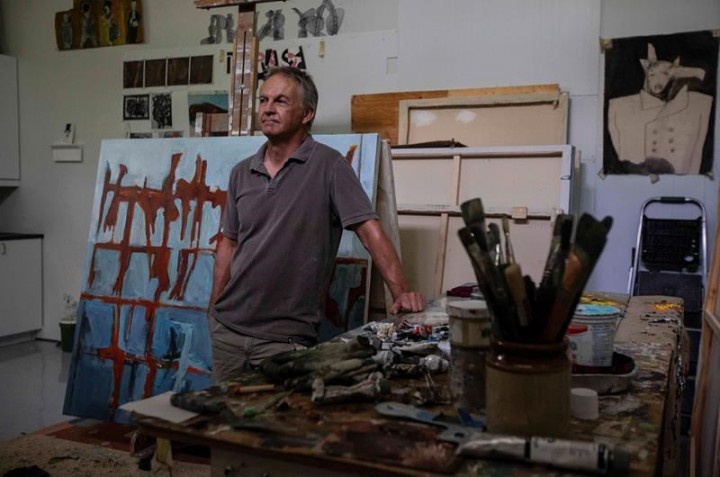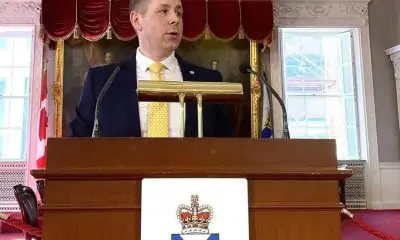Art
Artists to cash in when work is resold with update of copyright laws

OTTAWA — Artists are to get paid when their work is resold in a shakeup of copyright laws that would give them a slice of collectors’ profits.
Painters, sculptors and other visual artists stand to get a payout when their work is resold at auction and by galleries, in a government move designed to help sustain thousands of artists currently working below the poverty line.
Under reforms of copyright law, being drafted by Innovation Minister François-Philippe Champagne and Heritage Minister Pablo Rodriguez, artists would get a “resale right” giving them a royalty during the term of copyright, according to Champagne’s office.
Artists complain that they now get nothing if paintings and sculptures increase in value dramatically.
Montreal abstract artist Claude Tousignant, whose painting Accélérateur Chromatique 90 resold in 2012 for $110,000, is among the artists supporting reform of the law. He would have received $5,500 had changes to copyright law being prepared by Ministers, been in place when it was resold.
The late Inuk artist, Kenojuak Ashevak, sold a work called Enchanted Owl in 1960 for $24 and it was later resold for $158,500.
“Our government is currently advancing work on potential amendments to the Copyright Act to further protect artists, creators, and copyright holders,” said Laurie Bouchard, a spokeswoman for Champagne. “Resale rights for artists are indeed an important step toward improving economic conditions for artists in Canada.”
CARFAC, which represents Canadian artists, wants artists to get five per cent of the value of their work when it is resold, and for their estate to receive funds according to copyright rules decades after their death.
It says at least 90 countries, including the United Kingdom and France, already have resale rights for artists, but Canada is lagging behind, driving many artists to abandon their craft because they cannot make a living from it.
There are over 21,000 visual artists in Canada, and according to the 2016 census, their median income is $20,000 a year from all income sources.
“It’s important to really acknowledge that half of our artists live in poverty,” said April Britski, executive director of CARFAC. “We all benefit from arts and culture, and our creators deserve a better, more stable income.”
The forthcoming change in the law follows years of campaigning by Sen. Patricia Bovey, the first art historian in the Senate.
Bovey, former director of the Winnipeg Art Gallery, said France has had resale rights for over 100 years and the change to copyright laws is far overdue in Canada.
The senator said she knew of many artists who had sold works at the beginning of their careers for small sums, and seen them appreciate “by 10 times or more.”
Inuit artists, who often live in remote areas and sell locally, are among those who would particularly benefit if they get a slice of resale value at galleries and auctions.
“Artists are the group in Canada who make up the largest percentage of the working poor — below the poverty line,” Bovey said. “It’s our artists who tell us who we are, where we are, what we as a society face. If they can’t financially support themselves we will lose that really important window on who we are as Canadians.”
Paddy Lamb, an artist based in Edmonton, said it’s very hard to make a living in the arts even for established artists.
He said he had seen works leap in value when artists become established and their art is sold at major galleries or auction rooms.
“For Inuit artists, as soon as their work leaves Nunavut it immediately appreciates in value … and (the artists) receive none of that,” he said. “This is a tool to enable artists to make a living.”
He said Canadian artists know from artists from countries where resale rights are already in place, how important the payouts are to “help people out.”
“Most payouts in Britain come in smaller increments to artists who are not A-list artists,” Lamb said. “In Australia, a lot of that goes to Aboriginal artists. What we are asking for is a real good level playing field.”
CARFAC’s vice-president, Theresie Tungilik, an artist who lives in Rankin Inlet, said it is “unfair” that artists who see work resold are not “getting a penny from it.”
“I’ve been watching how the world has been treating its artists,” she said. “France has done this over a hundred years ago and it is important for all Canadian artists, including Inuit artists, that they have the same right.”
This report by The Canadian Press was first published Aug. 6, 2022.
Marie Woolf, The Canadian Press
Art
Calvin Lucyshyn: Vancouver Island Art Dealer Faces Fraud Charges After Police Seize Millions in Artwork

In a case that has sent shockwaves through the Vancouver Island art community, a local art dealer has been charged with one count of fraud over $5,000. Calvin Lucyshyn, the former operator of the now-closed Winchester Galleries in Oak Bay, faces the charge after police seized hundreds of artworks, valued in the tens of millions of dollars, from various storage sites in the Greater Victoria area.
Alleged Fraud Scheme
Police allege that Lucyshyn had been taking valuable art from members of the public under the guise of appraising or consigning the pieces for sale, only to cut off all communication with the owners. This investigation began in April 2022, when police received a complaint from an individual who had provided four paintings to Lucyshyn, including three works by renowned British Columbia artist Emily Carr, and had not received any updates on their sale.
Further investigation by the Saanich Police Department revealed that this was not an isolated incident. Detectives found other alleged victims who had similar experiences with Winchester Galleries, leading police to execute search warrants at three separate storage locations across Greater Victoria.
Massive Seizure of Artworks
In what has become one of the largest art fraud investigations in recent Canadian history, authorities seized approximately 1,100 pieces of art, including more than 600 pieces from a storage site in Saanich, over 300 in Langford, and more than 100 in Oak Bay. Some of the more valuable pieces, according to police, were estimated to be worth $85,000 each.
Lucyshyn was arrested on April 21, 2022, but was later released from custody. In May 2024, a fraud charge was formally laid against him.
Artwork Returned, but Some Remain Unclaimed
In a statement released on Monday, the Saanich Police Department confirmed that 1,050 of the seized artworks have been returned to their rightful owners. However, several pieces remain unclaimed, and police continue their efforts to track down the owners of these works.
Court Proceedings Ongoing
The criminal charge against Lucyshyn has not yet been tested in court, and he has publicly stated his intention to defend himself against any pending allegations. His next court appearance is scheduled for September 10, 2024.
Impact on the Local Art Community
The news of Lucyshyn’s alleged fraud has deeply affected Vancouver Island’s art community, particularly collectors, galleries, and artists who may have been impacted by the gallery’s operations. With high-value pieces from artists like Emily Carr involved, the case underscores the vulnerabilities that can exist in art transactions.
For many art collectors, the investigation has raised concerns about the potential for fraud in the art world, particularly when it comes to dealing with private galleries and dealers. The seizure of such a vast collection of artworks has also led to questions about the management and oversight of valuable art pieces, as well as the importance of transparency and trust in the industry.
As the case continues to unfold in court, it will likely serve as a cautionary tale for collectors and galleries alike, highlighting the need for due diligence in the sale and appraisal of high-value artworks.
While much of the seized artwork has been returned, the full scale of the alleged fraud is still being unraveled. Lucyshyn’s upcoming court appearances will be closely watched, not only by the legal community but also by the wider art world, as it navigates the fallout from one of Canada’s most significant art fraud cases in recent memory.
Art collectors and individuals who believe they may have been affected by this case are encouraged to contact the Saanich Police Department to inquire about any unclaimed pieces. Additionally, the case serves as a reminder for anyone involved in high-value art transactions to work with reputable dealers and to keep thorough documentation of all transactions.
As with any investment, whether in art or other ventures, it is crucial to be cautious and informed. Art fraud can devastate personal collections and finances, but by taking steps to verify authenticity, provenance, and the reputation of dealers, collectors can help safeguard their valuable pieces.
Art
Ukrainian sells art in Essex while stuck in a warzone – BBC.com
[unable to retrieve full-text content]
Ukrainian sells art in Essex while stuck in a warzone BBC.com

Source link
Art
Somerset House Fire: Courtauld Gallery Reopens, Rest of Landmark Closed
The Courtauld Gallery at Somerset House has reopened its doors to the public after a fire swept through the historic building in central London. While the gallery has resumed operations, the rest of the iconic site remains closed “until further notice.”
On Saturday, approximately 125 firefighters were called to the scene to battle the blaze, which sent smoke billowing across the city. Fortunately, the fire occurred in a part of the building not housing valuable artworks, and no injuries were reported. Authorities are still investigating the cause of the fire.
Despite the disruption, art lovers queued outside the gallery before it reopened at 10:00 BST on Sunday. One visitor expressed his relief, saying, “I was sad to see the fire, but I’m relieved the art is safe.”
The Clark family, visiting London from Washington state, USA, had a unique perspective on the incident. While sightseeing on the London Eye, they watched as firefighters tackled the flames. Paul Clark, accompanied by his wife Jiorgia and their four children, shared their concern for the safety of the artwork inside Somerset House. “It was sad to see,” Mr. Clark told the BBC. As a fan of Vincent Van Gogh, he was particularly relieved to learn that the painter’s famous Self-Portrait with Bandaged Ear had not been affected by the fire.
Blaze in the West Wing
The fire broke out around midday on Saturday in the west wing of Somerset House, a section of the building primarily used for offices and storage. Jonathan Reekie, director of Somerset House Trust, assured the public that “no valuable artefacts or artworks” were located in that part of the building. By Sunday, fire engines were still stationed outside as investigations into the fire’s origin continued.
About Somerset House
Located on the Strand in central London, Somerset House is a prominent arts venue with a rich history dating back to the Georgian era. Built on the site of a former Tudor palace, the complex is known for its iconic courtyard and is home to the Courtauld Gallery. The gallery houses a prestigious collection from the Samuel Courtauld Trust, showcasing masterpieces from the Middle Ages to the 20th century. Among the notable works are pieces by impressionist legends such as Edouard Manet, Claude Monet, Paul Cézanne, and Vincent Van Gogh.
Somerset House regularly hosts cultural exhibitions and public events, including its popular winter ice skating sessions in the courtyard. However, for now, the venue remains partially closed as authorities ensure the safety of the site following the fire.
Art lovers and the Somerset House community can take solace in knowing that the invaluable collection remains unharmed, and the Courtauld Gallery continues to welcome visitors, offering a reprieve amid the disruption.
-

 Sports4 hours ago
Sports4 hours agoPenguins re-sign Crosby to two-year extension that runs through 2026-27 season
-

 Politics8 hours ago
Politics8 hours agoNext phase of federal foreign interference inquiry to begin today in Ottawa
-

 Economy6 hours ago
Economy6 hours agoLiberals announce expansion to mortgage eligibility, draft rights for renters, buyers
-

 News8 hours ago
News8 hours agoFeds wary of back-to-work legislation despite employer demands: labour experts
-

 News8 hours ago
News8 hours agoVoters head to the polls for byelections in Montreal and Winnipeg
-

 News8 hours ago
News8 hours agoOntario considers further expanding pharmacists’ scope to include more minor ailments
-

 Economy6 hours ago
Economy6 hours agoStatistics Canada says manufacturing sales up 1.4% in July at $71B
-

 Real eState8 hours ago
Real eState8 hours agoNational housing market in ‘holding pattern’ as buyers patient for lower rates: CREA






























